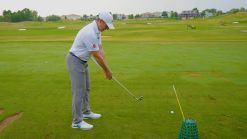Matt Henderson: Generate More Spin on Wedges
Matt Henderson discusses how to generate more spin on wedges in golf. Many golfers believe that hitting down on the ball is necessary to create spin. However, this often leads to dragging the loft along with the swing, resulting in compensations and trouble. Instead, the key to generating spin is creating friction between the ball and the clubface.
To understand how to control friction and spin, Henderson introduces the concept of the clubhead’s radius. He explains that the clubhead moves within a “blue hula hoop” representing its radius. The bottom of the divot marks the low point of this radius. To achieve good wedge play, it is important to manage the relationship between the loft of the club and the radius.
Compression Drill
Henderson suggests a drill called the “compression drill” to help golfers improve their wedge play. In this drill, a ball is teed up about half an inch off the ground. The goal is to hit the ball cleanly without taking a divot. By focusing on hitting the ball in the middle of the clubface, golfers can effectively manage the radius of their swing and generate more spin.
To perform the compression drill, Henderson recommends using a normal ball position and stance for a 50-yard wedge shot. The clubhead should contact the ball without any drastic downward movement, resulting in a neutral shaft lean and a clubhead that appears to move level to the ground. By teeing the ball up a half an inch, golfers can practice hitting the ball cleanly without taking a divot.









